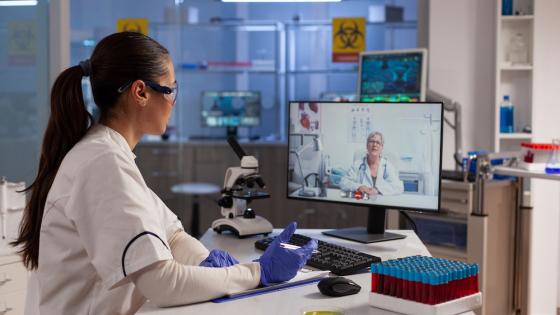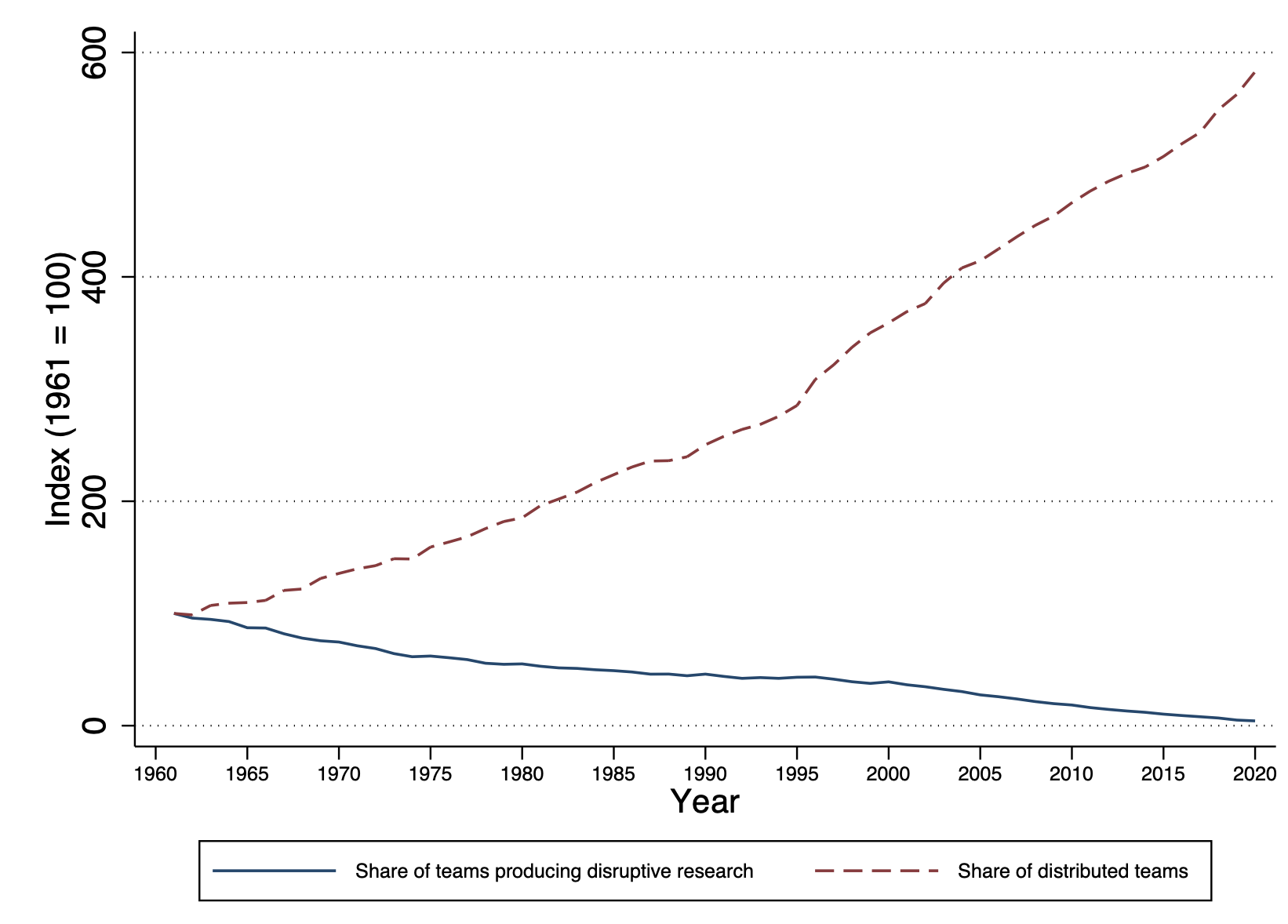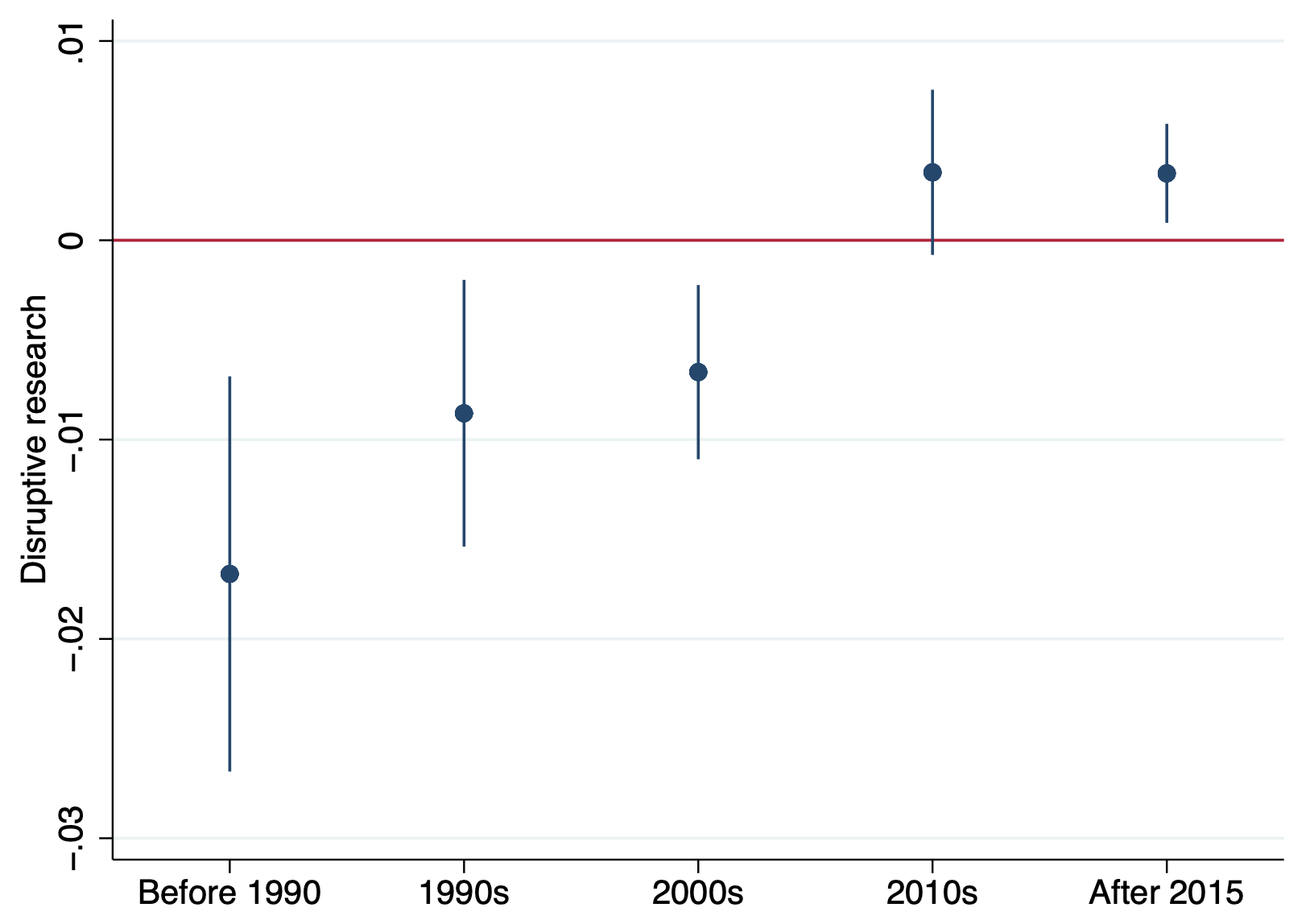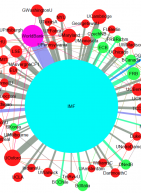A large literature shows that face-to-face interaction is critical for the cross-fertilisation of ideas. And yet, the share of geographically distributed teams in scientific research has steadily risen since the 1960s and accelerated further following the ICT revolution of the 1990s (Forman and van Zeebroeck 2012). In tandem, as shown in Figure 1, the percentage of fundamental or disruptive scientific discoveries has declined, implying that an ever-larger share of researchers focuses on incrementally developing existing ideas.
Figure 1 The rise of remote collaboration and the decline of disruptive discovery, 1961–2020
In a new study, we explore the link between the rise of remote collaboration and the demise of disruptive discovery in science (Chen et al. 2022). We do so against the background of an emerging body of work suggesting that new ideas have become harder to find. Indeed, since incremental discovery eventually runs into diminishing returns, the decline of breakthrough discoveries is consistent with Bloom et al. (2017), who show that the ‘innovation bang for the R&D buck’ – or research productivity – has fallen sharply in recent decades.
And yet, the literature has largely remained silent on the relationship between the sweeping organisational changes in scientific discovery and the types of ideas and projects being pursued. We seek to fill this empirical void.
Distribution and disruption
We use citation data for over 10 million research teams – publishing in eleven fields of research from 1961 to 2020 – collected from Microsoft Academic Graph (MAG). Conveniently, MAG also provides the affiliations of the authors on each paper, which allows us to infer whether a team is co-located or distributed.
To distinguish between disruptive and incremental discoveries, we follow Funk and Owen-Smith (2017) and Wu et al. (2019), who measure ‘disruptiveness’ based on citation patterns. The reasoning goes as follows: if a paper replaces the corpus of research it cites in subsequent citations, it can be deemed to have disrupted the existing body of knowledge.
As an example of a radical breakthrough, consider Katlin Kariko and Drew Weissman’s seminal 2005 paper, which demonstrated the promise of mRNA technology and opened up entirely new avenues of research. At the other end of the spectrum, BioNTech’s mRNA vaccine update in response to the Omicron variant can be regarded as an incremental adjustment of an existing idea.
Using a difference-in-difference design, we exploit instances in which co-located teams become distributed and compare the disruptiveness of their publications before and after the split, controlling for team characteristics and those of their research field. Based on this, we find a robust and persistent negative impact of switching to a distributed model on disruption.
The magnitude of the effect is also significant. On average, across the 60 years we study, the estimated probability of a team producing disruptive research is only 10%. And when a team splits, the chance of generating scientific breakthroughs is reduced by around 2 percentage points.
These findings speak to a growing literature on the effects of remote work (Barrero et al. 2021, Morikawa 2021). While studies show that working from home might increase productivity in routine and repetitive activities for which knowledge spillovers are less important (Bloom et al. 2015, Emanuel and Harrington 2020), there are also good reasons to believe that it inhibits the generation of new ideas, as distributed teams tend to become more siloed (Yang et al. 2021). On average, our results suggest that remote collaboration has not been inductive to creativity in scientific discovery.
The role of remote work technologies
That said, the relationship between in-person collaboration and disruption is unlikely to be time invariant. Indeed, the cost of coordination and communication at distance has fallen dramatically in recent decades following striking advances in ICT (Baldwin 2019).
When we explore the relationship between geographical dispersion and disruption over time (Figure 2), we find evidence that the onsite collaboration premium has become more muted over the decades, suggesting that the benefits of co-location have diminished, especially after the ICT revolution.
Figure 2 The impact of spatial distribution on disruptive discovery over time
This is not surprising. Though some tools, like Skype and Dropbox, began to spread in the 2000s, it is only after 2010 that many key remote work technologies emerged, including Trello/Office 356 (2011), Zoom/Google Drive (2012), Slack (2013), Overleaf (2014), and Microsoft Teams (2017).
Consistent with the idea that improvements in remote work technology are lowering the premium for in-person collaboration, we find co-location to be less important for disruptive discovery when teams split among countries with better digital infrastructure.
Expanding the ‘collective brain’
What is more surprising, however, is that the disruption gap between distributed and onsite teams does not just narrow over time. It even reverses after 2010, even though the latest-generation remote-work technologies remain imperfect substitutes for face-to-face interactions. For example, as Glaeser (1998) pointed out, digital technologies still only allow for interactions that are planned on at least one end. This means that sporadic encounters, which are highly important for innovation (Andrews 2019), simply do not happen in the virtual world.
At the same time, complementary knowledge, skills, and resources in different institutions might offset some of the downsides associated with remote collaboration. Put differently, better remote work technologies, which reduce communication frictions within teams, may allow their members to better leverage such complementarities. For example, individual scientists in distributed teams are likely to present and discuss their research with faculty in their respective departments. And as communication frictions within remote teams are reduced, spillovers from the local networks of members might benefit not just the individual, but also increasingly the wider team.
To explore this possibility, we examine how the effect of switching from onsite to distributed work differs depending on the quality of the institution a researcher moves to, using the university ranking provided by Times Higher Education. We find that spatial distribution harms disruptiveness irrespective of whether team members joined better-ranked universities before 2010. But thereafter, the wider team benefits if a member moves to more highly ranked institutions.
This suggests that before the last generation of remote work technologies, distributed teams were unable to harness the benefits of local knowledge spillovers and complementary resources, most likely due to communication frictions within the team. After 2010, however, they were better placed to do so.
Bearing this in mind, we caution against taking our findings to imply that face-to-face interactions no longer matter. Rather, they suggest that local networks and digital networks are complements rather than substitutes. Indeed, by connecting different local networks, remote collaboration increases the size of what Muthukrishna and Henrich (2016) have called the ‘collective brain’.
The future of productivity
As we write this column, the debate on the future of economic growth is ongoing (Gordon 2014, Mokyr 2014). One view is that productivity growth tends to follow a J-curve as complementary investments and organisational changes are required to realise the benefits of new technologies (Brynjolfsson et al. 2021), making a productivity resurgence likely, as happened with electricity and steam power (David 1990, Crafts 2004).
We agree. Our findings suggest that harnessing the benefits of the ICT revolution for remote collaboration similarly required complementary investments in technologies that support remote work. The COVID-19 pandemic has sparked a marked acceleration in patenting related to remote work technologies (Bloom et al. 2021). It might well also spark a revival of disruptive science and faster productivity growth.
References
Andrews, M (2019), “Bar talk: Informal social interactions, alcohol prohibition, and invention”, working paper.
Baldwin, R (2019), “Globalisation, automation and the history of work: Looking back to understand the future”, VoxEU.org, 31 January.
Barrero, J M, N Bloom and S J Davis (2021), “Let me work from home, or I will find another job”, VoxEU.org, 27 July.
Bloom, N, S J Davis and Y Zhestkova (2021), “COVID-19 shifted patent applications toward technologies that support working from home”, AEA Papers and Proceedings 111: 263–66.
Bloom, N, C Jones, Van J Reenen and M Webb (2017), “Ideas aren’t running out, but they are getting more expensive to find”, VoxEU.org, 20 September.
Bloom, N, J Liang, J Roberts and Z J Ying (2015), “Does working from home work? Evidence from a Chinese experiment”, Quarterly Journal of Economics 130(1): 165–218.
Brynjolfsson, E, D Rock and C Syverson (2021), “The productivity j-curve: How intangibles complement general purpose technologies”, American Economic Journal: Macroeconomics 13(1): 333–72.
Chen, C, C B Frey and G Presidente (2022), “Disrupting science”, Oxford Martin Working Paper Series on Technological and Economic Change No. 2022-4.
Crafts, N (2004), “Steam as a general purpose technology: A growth accounting perspective”, Economic Journal 114(495): 338–51.
David, P A (1990), “The dynamo and the computer: An historical perspective on the modern productivity paradox”, American Economic Review 80(2): 355–61.
Emanuel, N, and E Harrington (2020), “Working remotely? Selection, treatment and the market provision remote work”, Harvard University, mimeo.
Forman, C, and N van Zeebroeck (2012), “From wires to partners: How the internet has fostered R&D collaborations within firms”, Management Science 58(8): 1549–68.
Funk, R J, and J Owen-Smith (2017), “A dynamic network measure of technological change”, Management Science 63(3): 791–817.
Glaeser, E L (1998), “Are cities dying?”, Journal of Economic Perspectives 12(2): 139–60.
Gordon, R J (2014), “The turtle’s progress: Secular stagnation meets the headwinds”, in R Baldwin and C Teulings (eds.), Secular stagnation: Facts, causes, and cures, VoxEU.org eBook, September.
Mokyr, J (2014), “Secular stagnation? Not in your life”, in R Baldwin and C Teulings (eds.), Secular stagnation: Facts, causes, and cures, VoxEU.org eBook, September.
Morikawa, M (2021), “The productivity of working from home: Evidence from Japan”, VoxEU.org, 12 March.
Muthukrishna, M, and J Henrich (2016), “Innovation in the collective brain”, Philosophical Transactions of the Royal Society B: Biological Sciences 371(1690): 20150192.
Yang, L, D Holtz, S Jaffe, S Suri, S Sinha, J Weston, C Joyce, N Shah, K Sherman, B Hecht and J Teevan (2021), “The effects of remote work on collaboration among information workers”, Nature Human Behaviour 6: 43–54.
Wu, L, D Wang and J A Evans (2019), “Large teams develop and small teams disrupt science and technology”, Nature 566(7744): 378–82.





